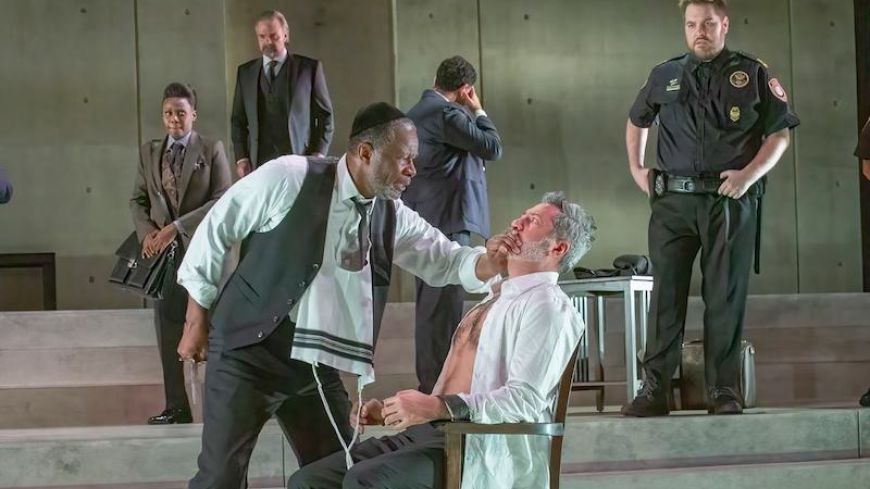
A few years ago, the actor, Juliet Stevenson suggested that future productions of ‘The Merchant of Venice’ should be cancelled as “It is full of anti-Semitism.”
But the counter argument surely is that the dramatic portrayal of racial/ religious discrimination needs to be seen by a wide audience. The 80th anniversary of the liberation of Auschwitz was commemorated on 27th January, 2025, but what have we learnt since 1945? Civil Rights Movement, Black Lives Matter, Israel/Gaza conflict, shootings at USA synagogues, Lawsuit to protect Jewish students at Harvard, global oppression for all 'outsiders', migrants, Muslims, LBGTQ.
Therefore, with topical resonance, ‘Theatre for a New Audience’ from Brooklyn, New York City, has not only set Shakespeare’s classic in ‘An American city in the near future’, but cast a black actor in the role of Shylock, the Jewish money lender. The stage set features tiered steps leading up to a grey, concrete, Brutalist-style building - rather like a modern church or synagogue - with a central round window and two large doors.
Antonio, the eponymous merchant is in conversation with his close friend Bassanio, who reveals he is in serious debt and is in dire need of financial help in order to travel to Belmont where he hopes to marry Portia, a wealthy heiress. Antonio gives Bassanio permission to borrow cash on his credit as he has invested his wealth in trading expeditions.
Shylock is at first reluctant to lend any money as he hates Antonio, a Christian, who has previously called him '.... a misbeliever, cut throat dog, and spat upon my Jewish gaberdine; well then, it now appears you need my help’.
With a sly smile, Shylock sees a way for potential retribution and agrees to lend 3,000 ducats for three months but Antonio must sign a bond to forfeit a pound of his flesh if he fails to repay the loan on time. Bassanio distrusts Shylock but Antonio is expecting a great financial return from his trade deals.
Characters are very well portrayed – Alfredo Narciso’s Antonio is a smart, slick, city slicker with the tailored, fashionable look of NYC/Italiano entrepreneurial success. Gratiano wears his hair in a pony tail, baseball cap, slogan T shirt, to reflect his wild and witty persona. Through stature, stance and aura, John Douglas Thomson as Shylock, wearing a three piece suit, traditional yarmulke and tassled tallit katan, displays such a powerful presence as a respected, respectable businessman. He is not one to suffer fools - and prejudice - lightly.
The elegant young Portia, bound by her father’s will, can only marry the man who chooses the correct gold, silver or lead casket. Her delightfully camp servant, Balthazar introduces her to three suitors: first, the Prince of Morocco, and she is so relieved when he does not select the right box, expressing unexpected, racial contempt.
‘A gentle riddance!.
Let all of his complexion choose me so’.
Varin Ayala adopts such a melodramatic stereotype for Prince of Arragon, you almost expect him to click his castanets and dance the flamenco. Then, dressed in a white tuxedo, Bassanio is handsome and charming with sophisticated style; Portia seems to gasp and go weak at the knees at finding the perfect suitor, and can only try and hint and pray that he picks the casket containing portrait.
The cast deliver the lines with such a natural flow and tone of voice which suits the range of New York/American accents; such clarity of meaning, translating Shakespeare’s poetic rhythm into the phrasing of modern speech. Just as you wait with bated breath to hear how Hamlet will recite, ‘To be or not to be’, a similar moment here when Shylock demands that Antonio accepts the blatant truth:
‘If you prick us, do we not bleed? If you tickle us, do we not laugh? If you poison us, do we not die? And if you wrong us, shall we not revenge?’
Thompson keeps the tone of his voice low and husky, spitting out the words in a mood of simmering anger to explain precisely why he is as much a human being as any Christian.
As the narrative unfolds there is however little action as all private conversations appear to take place outside in a public place with no change of theatrical setting. Direction is more about choreography as the actors stand or sit, moving like chess pieces up and down the various levels of the wide steps with no atmospheric sense of place to distinguish between the scenes which take place around Venice and in Belmont.
It all culminates in a gripping Trial to settle the financial Bond between Antonio and Shylock, with a barrage of legal arguments firing to and fro like smashing volleys and winning drop shots at Wimbledon.
Antonio has the support of a young advocate (Portia in Ally McBeal mode, disguised in suit and tie) while Shylock, is completely on his own as a sole prosecutor. At first, he is the one who is confident of securing the bond, ready with his scales and knife to take his rightful pound of flesh. However, faced with Bassanio and Gratiano’s cruel verbal abuse and Portia finding a loophole in the bond, he cowers in dismay like a wounded animal.
In 1701, George Granville changed the title of his production to The Jew of Venice, to give credit to Shylock as the central character. Now, 324 years on, John Douglas Thompson gives an electrifying performance, enriched with psychological insight and emotional pathos; his poignant, personal message is simple, we must all question and retaliate against an unjust society which condones prejudicial discrimination.
No wonder Thompson has been described as “perhaps the greatest Shakespeare interpreter in contemporary American theater.” New York Times
Showtimes:
18 January – 15 February, 2025,
Tues-Sat, 7.30pm. Wed & Sat, Matinee, 2.30pm
Tickets: from £18. Concessions available.
https://lyceum.org.uk/events/the-merchant-of-venice

